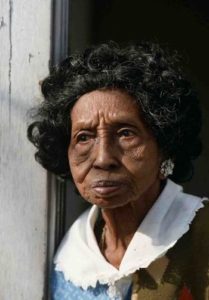
Clementine Hunter
On this date, we celebrate the birth of Black folk artist Clementine Hunter in 1886.
Hunter was born on Hidden Hill Plantation near Cloutierville, Louisiana, a place so isolated and harsh that local legend claimed it was the real-life inspiration for Uncle Tom's Cabin. Her family moved north to the Cane River area when she was a child, and eventually, they moved to Melrose Plantation near Natchitoches, where Hunter spent much of her life picking cotton.
She attended school for ten days and never learned to read or write. Later, she cooked for the Plantations Big House, using her creative spirit to make dolls for the children and quilts, baskets, and lace curtains.
But in the late 1940s, one of the many artists who visited the plantation left behind some paint tubes. Plantation curator Francois Mignon encouraged Hunter to try her hand at painting. During the next four decades, she created thousands of paintings. Hunter worked all day at the plantation Big House and took home washing and ironing to be returned the next day. Once home, she took care of her worthless husband.
It was often midnight before she was free to ''mark some pictures,'' as she once said of her painting, using cardboard, paper bags, lumber scraps, milk jugs, the insides of soapboxes, and other throw-outs. Almost all of her works were ''memory paintings,'' showing plantation life as she remembered it: picking cotton, gathering figs, threshing pecans, weddings, baptisms, funerals, and other scenes of everyday life. Her titles were often intriguing, too.
Collectors selected some simple ones and were merely descriptive of their content: Watermelon, Flowers, Ducks, etc. When collectors did ask for a title, Hunter gave her own, such as "Trying to Keep the Baby Happy," "She's Not Pretty, But She's Strong,” and "Saturday Night at the Honky Tonk." Visitors to the plantation would buy her paintings, starting at 25 cents and 50 cents in the 1940s. Contemporary collectors consider these early works her best. Eventually, her patrons could get her work into shows, the first big being the New Orleans Arts and Crafts Show in 1949.
A June 1953 article in Look magazine brought her to national attention. In 1957, some critics dubbed her “'the Black Grandma Moses.” And in 1979, Robert Bishop, director of The Museum of American Folk Art in Washington, called the artist, then in her 90s, ''the most celebrated of all Southern contemporary painters.” By the 1970s, there were large public and private collections of Hunter's work, and by the 1980s, several important traveling exhibitions featured her paintings. The prices for her work had risen from 25 cents to several thousand dollars.
In the last years of her life, Hunter left her rented cabin and moved upriver, living in a trailer she bought with money from selling her paintings. She painted until the last few months of her life, dying at 100 on January 1, 1988. Hunter was more modest about her abilities. "God puts those pictures in my head, and I just put them on the canvas, like He wants me to," the she said.
Black Women in America: An Historical Encyclopedia
Volumes 1 and 2, edited by Darlene Clark Hine
Copyright 1993, Carlson Publishing Inc., Brooklyn, New York
ISBN 0-926019-61-9